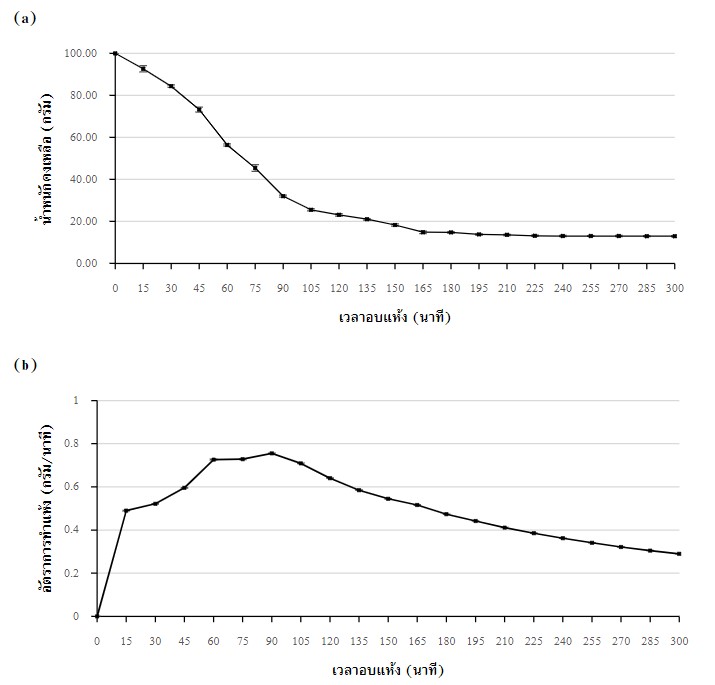Effect of Herp Seasoning on Physicochemical, Antioxidative and Sensory Properties of Seasoned Crispy Oyster Mushroom
Keywords:
oyster mushroom, herb seasoning powder, antioxidant activity, healthy foodAbstract
The objective of this research was to examine the effect of herp seasoning on physicochemical, antioxidative and sensory properties of seasoned crispy oyster mushroom by studying the drying of oyster mushrooms with a hot-air drier, and the physicochemical, antioxidative and sensory qualities of herb seasoning powders and herb flavored crispy oyster mushrooms. It was found that the mushroom drying at 70 ˚C by a hot-air drier provided a drying rate of 0.47 g/min, 11.54%yield, phenolic compounds and antioxidant activity DPPH of 148.44 and 17.75 mg gallic acid equivalent per 100 g, respectively. There were 3 formulas of herbal flavors, namely sesame and pepper flavor, chilli paste flavor and Tom Yum flavor. The crispy mushroom Tom Yum flavor contained the highest phenolic compound content and DPPH antioxidant activity (160.05 and 17.35 mg gallic acid equivalent per 100 g, respectively) (p<0.05). The suitable process of crispy oyster mushrooms with herbal flavors was a production process by drying oyster mushrooms at 70 ˚C for 3 hours, then frying and mixing with Tom Yum seasoning powder at a ratio of mushroom to seasoning powder as 5:1. The ingredients for Tom Yum seasoning powder were Chaya Spinash leaves, sugar, salt, pepper, kaffir lime leaves, lemongrass, galangal and citric acid as 21.58%, 21.58%, 17.99%, 10.79%, 10.07%, 7.19%, 7.19% and 3.61%, respectively, with the most accepted by consumers.
References
Aishah, M. S. & Wan Rosli, W. I. (2013). The effect of addition of oyster mushroom (Pleurotus sajor-caju) on nutrient composition and sensory acceptation of selected wheat and rice-based products. International Food Research Journal, 20(1), 183-188.
Bernas, E., Jaworska,G. & Lisiewska,Z. (2006). Edible mushrooms as a source of valuable nutritive constituents. Acta Scientiarum Polonorum, Technologia Alimentaria, 5(1), 5-20.
Chang, S.T. & Miles, P.G. (2004). Mushroom cultivation, nutritional values,medicinal effect, and environmental impact(2nded.). CRC Press.
Changthog, N. & Chunthanom, P. (2017). The effect of seasoning fried log white mushroom processing on the consumer acceptance. Khon Kaen Agriculture Journal, 45(1), 1611-1616. (in Thai)
Kanagasabapathy, G., Malek, S. N. A., Kuppusamy, U. R. & Vikineswary, S. (2011). Chemical composition and antioxidant properties of extracts of fresh fruiting bodies of Pleurotus sajor-caju(Fr.) Singer. Journal of Agricultural and Food Chemistry, 59(6), 2618-2626.doi: 10.1021/jf104133g
Kuri-GarcÃa, A., & GuzmÃ, S. H. (2017). Phenolic profile and antioxidant capacity of Cnidoscolus chayamansa and Cnidoscolus aconitifolius: A review.Journal of Medicinal Plants Research,11(45), 713-727. doi.org/10.5897/jmpr2017.6512
Liaotrakoon, W., & Liaotrakoon, V. (2018). Influence of drying process on total phenolics, antioxidative activity and selected physical properties of edible bolete (Phlebopus colossus (R. Heim) Singer) and changes during storage.Food Science and Technology,38, 231-237.http://dx.doi.org/10.1590/1678-457x.34116
Liaotrakoon, W., De Clercq, N., Van Hoed, V., Van de Walle, D., Lewille, B. &Dewettinck, K. (2013). Impact of thermal treatment on physicochemical, antioxidative and rheological properties of white-flesh and red-flesh dragon fruit (Hylocereusspp.) purees. Food and Bioprocess Technology, 6(2), 416-430. doi.org/10.1007/s11947-011-0722-4
Lim, Y. Y., Lim, T. T. & Tee, J. J. (2007). Antioxidant properties of several tropical fruits: a comparative study. Food Chemistry, 103(3), 1003-1008.http://dx.doi.org/10.1016/j.foodchem.2006.08.038
Picardi, S. M., & Issenberg, P. (1973). Investigation of some volatile constituents of mushrooms (Agaricus bisporus): Changes which occur during heating. Journal of Agricultural and Food Chemistry, 21, 959-962.
Politowicz, J., Lech, K., Sánchez-Rodríguez, L., Figiel, A., Szumny, A., Grubor, M. & Carbonell-Barrachina, Á.A. (2018). Volatile composition and sensory profile of oyster mushroom as affected by drying method. Drying Technology, 36, 685 -696.
Ruengthurakit, W., Patanathavorn, N. & Wongpakdee, C. (2015). Mushroom drying by hot air[Master’s thesis]. Burapha University. (in Thai)
Saiful Bahri, S. & Wan Rosli, W. l. (2016). Effect of oyster mushroom (Pleurotus sajor-caju) addition on the nutritional composition and sensory evaluation of herbal seasoning. International Food Research Journal, 23(1), 262-268.
Sawetwongsakoon, B.(2010). Study on processing of crispy seasoned grey oyster mushroom. Nakhon Si Thammarat Rajabhat University. (in Thai)
Terpinc, P., Čeh, B., Ulrih, N.P. & Abramovič, H. (2012). Studies of the correlation between antioxidant properties and the total phenolic content of different oil cake extracts. Industrial Crops and Products, 39, 210-217. doi.org/10.1016/j.indcrop.2012.02.023
Tomsone, L., Kruma, Z. &Galoburda, R. (2012). Comparison of different solvents and extraction methods for isolation of phenolic compounds from Horseradish roots (Armoracia rusticana). International Journal of Biological, Biomolecular, Agricultural, Food and Biotechnological Engineering,6,236–241.
Usami, A., Nakaya, S., Nakahashi, H. & Miyazawa, M. (2014). Chemical composition and aroma evaluation of volatile oils from edible mushrooms (Pleurotus salmoneostramineus and Pleurotus sajor-caju). Journal of Oleo Science,63(12), 1323-1332. http://dx.doi.org/10.5650/jos.ess14147
Vongsawasdi, P., Nopharatana, M., Dejsuk, N., Yodying, P., Aimratchanee, P. & Tripanyasatara, P. (2011). Effect of pre-fried treatments on oil absorption of deep-fat fried mushroom. Agricultural Science Journal, 42(2), 513-516. (in Thai)
Wan Rosli, W. I., Nurhanan A. R. & Aishah, M. S. (2012). Effect of partial replacement of wheat flour with oyster mushroom (Pleurotus sajor-caju) powder on nutritional composition and sensory properties of butter biscuit. Sains Malaysiana, 41(12), 1565–1570.
Wongsa, P., Jiranun C. & Anis, Z. (2012). In vitro screening of phenolic compounds, potential inhibition against α-amylase and α-glucosidase of culinary herbs in Thailand. Food Chemistry, 131(3), 964-971. doi.org/10.1016/j.foodchem.2011.09.088
Wu, L. C., Hsu, H. W., Chen, Y. C., Chiu, C. C., Lin, Y. I. & Ho, J. A. A. (2006). Antioxidant and antiproliferative activities of red pitaya. Food Chemistry, 95(2), 319-327. doi: 10.1016/j.foodchem.2005.01.002
Yao, F., Gao, H., Yin, C.-M., Shi, D.-F. & Fan, X.-Z. (2023). Effect of different cooking methods on the bioactive components, color, texture, microstructure, and volatiles of Shiitake mushrooms, Foods, 12(13).doi.org/10.3390/foods12132573
Yuenyongputtakal, W. & Limroongreungrat, K. (2015). Study of phytonutrients content from mycelia of commercially mushrooms and application of mushroom micelia powder used in food product. Resreach Report. Faculty of Science, Burapha University. 170 pp. (in Thai)

Downloads
Published
Issue
Section
Categories
License
Copyright (c) 2024 Journal of Applied Science and Emerging Technology

This work is licensed under a Creative Commons Attribution-NonCommercial-NoDerivatives 4.0 International License.

